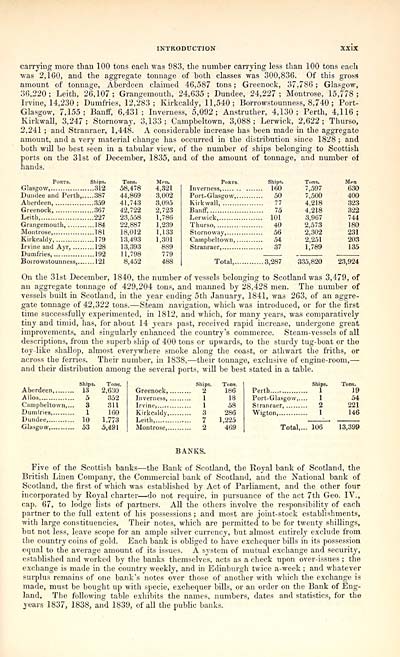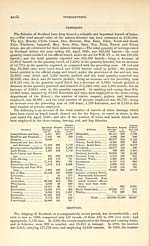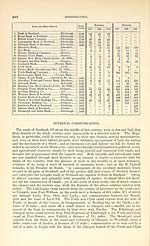Topographical, statistical, and historical gazetteer of Scotland > Volume 1
(41) Page xxix
Download files
Complete book:
Individual page:
Thumbnail gallery: Grid view | List view

INTRODUCTION
XXIX
carrying more than 100 tons each was 983, the number carrying less than 100 tons each
was 2,160, and the aggregate tonnage of both classes was 300,836. Of this gross
amount of tonnage, Aberdeen claimed 46,587 tons ; Greenock, 37,786 ; Glasgow,
36,220; Leith, 26,107; Grangemouth, 24,635; Dundee, 24,227; Montrose, 15,778;
Irvine, 14,230 ; Dumfries, 12,283 ; Kirkcaldy, 11,540 ; Borrowstounness, 8,740 ; Port-
Glasgow, 7,155; Banff, 6,431; Inverness, 5,092; Anstruther, 4,130; Perth, 4,116;
Kirkwall, 3,247; Stornoway, 3,133; Campbeltown, 3,088; Lerwick, 2,622; Thurso,
2,241 ; and Stranraer, 1,448. A considerable increase has been made in the aggregate
amount, and a very material change has occurred in the distribution since 1828 ; and
both will be best seen in a tabular view, of the number of ships belonging to Scottish
ports on the 31st of December, 1835, and of the amount of tonnage, and number of
hands.
Ports. Ships.
Glasgow, 312
Dundee and Perth 387
Aberdeen, 359
Greenock, 367
Leith, 227
Grangemouth, 184
Montrose, 181
Kirkcaldy, 179
Irvine and Ayr, 128
Dumfries, 192
Borrowstounness,.. 121
Tone.
Men.
58,478
4,321
44,869
3,002
41,743
3,095
42,722
2,723
23,558
1,786
22,887
1,239
18,012
1,133
13.493
1,301
13,393
889
11,798
779
8,452
488
Ports. Ships.
Inverness, 160
Port-Glasgow, 50
Kirkwall, 77
Banff, 75
Lerwick, 101
Thurso, 40
Stornoway, 56
Campbeltown, 54
Stranraer, 37
Tons.
Mt»n
7,597
630
7,500
400
4,218
323
4,218
322
3,967
744
2,573
180
2,302
231
2,251
203
1,789
135
Total, 3,287 335,820 23,924
On the 31st December, 1840, the number of vessels belonging to Scotland was 3,479, of
an aggregate tonnage of 429,204 tons, and manned by 28,428 men. The number of
vessels built in Scotland, iu the year ending 5th January, 1841, was 263, of an aggre-
gate tonnage of 42,322 tons. — Steam navigation, which was introduced, or for the first
time successfully experimented, in 1812, and which, for many years, was comparatively
tiny and timid, has, for about 14 years past, received rapid increase, undergone great
improvements, and singularly enhanced the country's commerce. Steam-vessels of all
descriptions, from the superb ship of 400 tons or upwards, to the sturdy tug-boat or the
toy like shallop, almost everywhere smoke along the coast, or athwart the friths, or
across the ferries. Their number, in 1838, — their tonnage, exclusive of engine-room, —
and their distribution among the several ports, will be best stated in a table.
Ships. Tone.
Aberdeen 13 2,630
Alloa, 5 352
Campbeltown,... 3 311
Dumfries 1 160
Dundee,, 10 1,773
Glasgow,. 53 3,491
Ships. Tone.
Greenock, 2 186
Inverness 1 18
Irvine, 1 58
Kirkcaldy 3 286
Leith, 7 1,225
Montrose, 2 469
Perth
Port-Glasgow,....
Stranraer
Wigton,
Ships.
1
1
2
1
Total,... 106
Tons.
19
54
221
146
13,399
BANKS.
Five of the Scottish banks — the Bank of Scotland, the Royal bank of Scotland, the
British Linen Company, the Commercial bank of Scotland, and the National bank of
Scotland, the first of which was established by Act of Parliament, and the other four
incorporated by Royal charter — do not require, in pursuance of the act 7th Geo. IV.,
cap. 67, to lodge lists of partners. All the others involve the responsibility of each
partner to the full extent of his possessions ; and most are joint-stock establishments,
with large constituencies. Their notes, which are permitted to be for twenty shillings,
but not less, leave scope for an ample silver currency, but almost entirely exclude from
the country coins of gold. Each bank is obliged to have exchequer bills in its possession
equal to the average amount of its issues. A system of mutual exchange and security,
established and worked by the banks themselves, acts as a check upon over-issues ; the
exchange is made in the country weekly, and in Edinburgh twice a-week ; and whatever
surplus remains of one bank's notes over those of another with which the exchange is
made, must be bought up with specie, exchequer bills, or an order on the Bank of Eng-
land. The following table exhibits the names, numbers, dates and statistics, for the
years 1837, 1838, and 1839, of all the public banks.
XXIX
carrying more than 100 tons each was 983, the number carrying less than 100 tons each
was 2,160, and the aggregate tonnage of both classes was 300,836. Of this gross
amount of tonnage, Aberdeen claimed 46,587 tons ; Greenock, 37,786 ; Glasgow,
36,220; Leith, 26,107; Grangemouth, 24,635; Dundee, 24,227; Montrose, 15,778;
Irvine, 14,230 ; Dumfries, 12,283 ; Kirkcaldy, 11,540 ; Borrowstounness, 8,740 ; Port-
Glasgow, 7,155; Banff, 6,431; Inverness, 5,092; Anstruther, 4,130; Perth, 4,116;
Kirkwall, 3,247; Stornoway, 3,133; Campbeltown, 3,088; Lerwick, 2,622; Thurso,
2,241 ; and Stranraer, 1,448. A considerable increase has been made in the aggregate
amount, and a very material change has occurred in the distribution since 1828 ; and
both will be best seen in a tabular view, of the number of ships belonging to Scottish
ports on the 31st of December, 1835, and of the amount of tonnage, and number of
hands.
Ports. Ships.
Glasgow, 312
Dundee and Perth 387
Aberdeen, 359
Greenock, 367
Leith, 227
Grangemouth, 184
Montrose, 181
Kirkcaldy, 179
Irvine and Ayr, 128
Dumfries, 192
Borrowstounness,.. 121
Tone.
Men.
58,478
4,321
44,869
3,002
41,743
3,095
42,722
2,723
23,558
1,786
22,887
1,239
18,012
1,133
13.493
1,301
13,393
889
11,798
779
8,452
488
Ports. Ships.
Inverness, 160
Port-Glasgow, 50
Kirkwall, 77
Banff, 75
Lerwick, 101
Thurso, 40
Stornoway, 56
Campbeltown, 54
Stranraer, 37
Tons.
Mt»n
7,597
630
7,500
400
4,218
323
4,218
322
3,967
744
2,573
180
2,302
231
2,251
203
1,789
135
Total, 3,287 335,820 23,924
On the 31st December, 1840, the number of vessels belonging to Scotland was 3,479, of
an aggregate tonnage of 429,204 tons, and manned by 28,428 men. The number of
vessels built in Scotland, iu the year ending 5th January, 1841, was 263, of an aggre-
gate tonnage of 42,322 tons. — Steam navigation, which was introduced, or for the first
time successfully experimented, in 1812, and which, for many years, was comparatively
tiny and timid, has, for about 14 years past, received rapid increase, undergone great
improvements, and singularly enhanced the country's commerce. Steam-vessels of all
descriptions, from the superb ship of 400 tons or upwards, to the sturdy tug-boat or the
toy like shallop, almost everywhere smoke along the coast, or athwart the friths, or
across the ferries. Their number, in 1838, — their tonnage, exclusive of engine-room, —
and their distribution among the several ports, will be best stated in a table.
Ships. Tone.
Aberdeen 13 2,630
Alloa, 5 352
Campbeltown,... 3 311
Dumfries 1 160
Dundee,, 10 1,773
Glasgow,. 53 3,491
Ships. Tone.
Greenock, 2 186
Inverness 1 18
Irvine, 1 58
Kirkcaldy 3 286
Leith, 7 1,225
Montrose, 2 469
Perth
Port-Glasgow,....
Stranraer
Wigton,
Ships.
1
1
2
1
Total,... 106
Tons.
19
54
221
146
13,399
BANKS.
Five of the Scottish banks — the Bank of Scotland, the Royal bank of Scotland, the
British Linen Company, the Commercial bank of Scotland, and the National bank of
Scotland, the first of which was established by Act of Parliament, and the other four
incorporated by Royal charter — do not require, in pursuance of the act 7th Geo. IV.,
cap. 67, to lodge lists of partners. All the others involve the responsibility of each
partner to the full extent of his possessions ; and most are joint-stock establishments,
with large constituencies. Their notes, which are permitted to be for twenty shillings,
but not less, leave scope for an ample silver currency, but almost entirely exclude from
the country coins of gold. Each bank is obliged to have exchequer bills in its possession
equal to the average amount of its issues. A system of mutual exchange and security,
established and worked by the banks themselves, acts as a check upon over-issues ; the
exchange is made in the country weekly, and in Edinburgh twice a-week ; and whatever
surplus remains of one bank's notes over those of another with which the exchange is
made, must be bought up with specie, exchequer bills, or an order on the Bank of Eng-
land. The following table exhibits the names, numbers, dates and statistics, for the
years 1837, 1838, and 1839, of all the public banks.
Set display mode to: Large image | Transcription
Images and transcriptions on this page, including medium image downloads, may be used under the Creative Commons Attribution 4.0 International Licence unless otherwise stated. ![]()
| Gazetteers of Scotland, 1803-1901 > Topographical, statistical, and historical gazetteer of Scotland > Volume 1 > (41) Page xxix |
|---|
| Permanent URL | https://digital.nls.uk/97438038 |
|---|
| Description | Volume first. A-H. |
|---|---|
| Attribution and copyright: |
|

